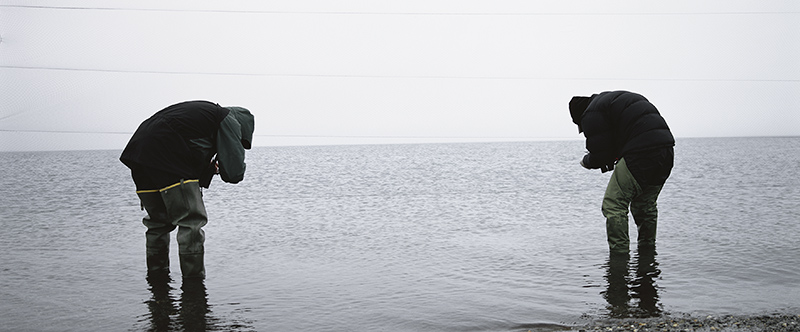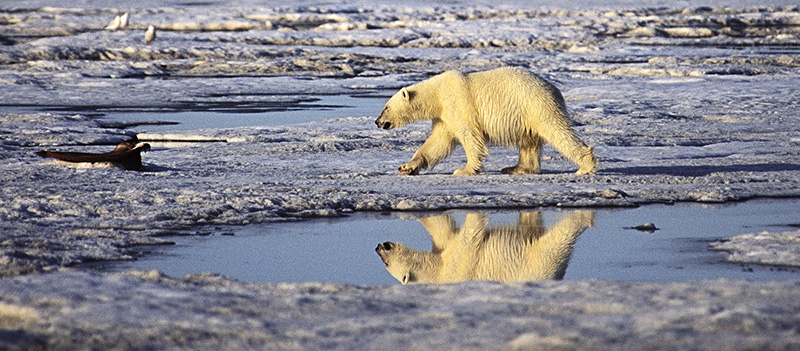
SELECT STORIES FROM THE ARCHIVE—2010–2015
by Subhankar Banerjee, with introduction by Tom Engelhard
TomDispatch.com of The Nation Institute, 3 March 2015

On this day in early July, we saw nearly 1,000 whales with newborn calves within a one–mile stretch. Photograph by Subhankar Banerjee.
Here’s a Jeopardy!–style question for you: “Eight different species of whales can be seen in these two American seas.” Unless you’re an Iñupiaq, a marine biologist, or an Arctic enthusiast like me, it’s a pretty good guess that you can’t tell me what those seas are or what those whales are either. The answer: the Chukchi Sea and the adjacent Beaufort Sea, off Arctic Alaska, and you can commonly spot bowhead, beluga, and grey whales there, while fin whales, minkes, humpbacks, killer whales, and narwhals are all venturing into these seas ever more often as the Arctic and its waters continue to warm rapidly.
The problem, however, is that the major oil company Royal Dutch Shell wants to drill in the Chukchi Sea this summer and that could, in the long term, spell doom for one of the last great, relatively untouched oceanic environments on the planet. Let me explain why Shell’s drilling ambitions are so dangerous.
CONTINUE READING STORY ON TOMDISPATCH.COM
![]()
The article also got published in a number of other places: AlterNet |
Asia Times |
Common Dreams |
Countercurrents |
Energy Post |
Global Possibilities |
Guernica |
Huffington Post |
Juan Cole’s Informed Comment |
Le Monde diplomatique |
Moyers & Company |
The Nation |
Nation of Change |
The Real News |
Resilience |
Salon |
Truthdig |
Truthout |
Utne Reader |
War in Context |
YubaNet
To the Point | Public Radio International: On March 4, Subhankar did a radio interview with Warren Olney, host of To the Point, a nationally syndicated program on the Public Radio International. To listen online go down the page to the third segment, “Oil Companies Could Be a Nightmare for the Whales of the Arctic.” It’s about 10 minutes long. LISTEN ONLINE
![]()
by Subhankar Banerjee, September 27, 2013

The Arctic sea ice is the most famous visual indicator of climate change. This year the climate deniers took the lead to explain what’s going on with the Arctic sea ice. “And now it’s global COOLING! Record return of Arctic ice cap as it grows by 60% in a year,” by David Rose in the Mail on Sunday, and “Global warming? No, actually we’re cooling, claim scientists” by Hayley Dixon in The Telegraph—both published on September 8—led the parade. Quoting all these irresponsible disinformation, on September 10, Greg Gutfeld of Fox News put an end to global warming with these words: “Global warming? Yes, it’s finally dead.”
By Subhankar Banerjee, August 2, 2012

When you go to the mountains, you go to the mountains. When it’s the desert, it’s the desert. When it’s the ocean, though, we generally say that we’re going “to the beach.” Land is our element, not the waters of our world, and that is an unmistakable advantage for any oil company that wants to drill in pristine waters.
By Subhankar Banerjee, August 15, 2011

One of the riskiest and most destructive extreme energy oil exploration projects on the planet is moving toward implementation without scientific understanding or technical preparedness—Shell’s oil drilling in the Arctic Ocean of Alaska.
By Christine Shearer, December 1, 2010

In 2008, a small Inupiat village in Alaska sued ExxonMobil and 23 other fossil fuel companies including Peabody Energy and BP for contributing to the destruction of their homeland, and charged a smaller subset with deliberately creating a false debate around climate change science. You might have heard of the lawsuit—Kivalina v. ExxonMobil et al.
By Rosemary Ahtuangaruak, November 23, 2010

This week families across the country will be celebrating Thanksgiving—sharing food and telling stories. Here is my story about our food and culture that would be destroyed if Shell Oil gets the permit to drill for oil in our homeland—the Beaufort and Chukchi Seas.
By Mariel Nanasi, July 25, 2011

It’s time we secure a future without coal in New Mexico, across America, and around the world. It won’t be easy. Along the way, we will need a lot of help, creativity and inspiration.
News Update: In a July 28 front–page article “Enviros win voice in carbon battle,” in the Santa Fe New Mexican, the Associated Press writer Susan Montoya Bryan reports, “The New Mexico Supreme Court on Wednesday (July 27) cleared the way for environmental groups to intervene in an ongoing legal battle over whether the state should regulate greenhouse–gas emissions.” You can read the full article here.
By Dr. Vandana Shiva, February 23, 2011

Women for Diversity: One of the campaigns of Navdanya. Photo courtesy Navdanya.
Industrial globalised agriculture is heavily implicated in climate change. It contributes to the three major greenhouse gases: carbon dioxide (CO2) from the use of fossil fuels, nitrogen oxide (N2O) from the use of chemical fertilizers and methane (CH4) from factory farming. According to the Intergovernmental Panel on Climate change (IPCC), atmospheric concentration of CO2 has increased from a pre–industrial concentration of about 280 parts per million to 379 parts per million in 2005. The global atmospheric concentration of CH4 has increased from pre–industrial concentration of 715 parts per billion to 1774 parts per billion in 2005. The global atmospheric concentration of N2O, largely due to use of chemical fertilizers in agriculture, increased from about 270 parts per billion to 319 parts per billion in 2005.
Industrial agriculture is also more vulnerable to climate change which is intensifying droughts and floods. Monocultures lead to more frequent crop failure when rainfall does not come in time, or is too much or too little. Chemically fertilized soils have no capacity to withstand a drought. And cyclones and hurricanes make a food system dependent on long distance transport highly vulnerable to disruption.
By Dr. Terry Gosliner, October 16, 2010

For almost three decades I’ve been studying nudibranchs in the tropical Indian and Pacific Oceans. Nudibranchs are beautiful and brightly colored sea slugs that thrive on healthy coral reefs. While that has been exhilarating, it is the changes that I’ve seen on these reefs that make me sit upright in bed in the middle of the night. Climate change is seriously endangering these richest reservoirs of marine biodiversity. Here is my story of some of these alarming changes.
By Subhankar Banerjee, August 26, 2010

Imagine you live in New York City, and one fine morning you awake to the realization that 90 percent of all the buildings that were more than five stories tall have been destroyed. You will hardly have the words to talk about this devastation, but I’m sure you will walk around the rubble to make sense of it all.
Something similar has happened in and around Santa Fe, New Mexico, where I currently live. Between 2001 and 2005, aerial surveys were conducted over 6.4 million acres of the state. Some 816,000 affected acres were mapped and it was found that during this short period Ips confusus, a tiny bark beetle, had killed 54.5 million of New Mexico’s state tree, the piñon. In many areas of northern New Mexico, including Santa Fe, Los Alamos, Española, and Taos, 90 percent of mature piñons are now dead.
By Subhankar Banerjee, May 25, 2010

When you go to the mountains, you go to the mountains. When it’s the desert, it’s the desert. When it’s the ocean, though, we generally say that we’re going “to the beach.” Land is our element, not the waters of our world, and that is an unmistakable advantage for any oil company that wants to drill in pristine waters.